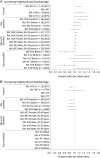Neighborhood Socioeconomic Status and Stroke Incidence: A Systematic Review
- PMID: 33766995
- PMCID: PMC8166445
- DOI: 10.1212/WNL.0000000000011892
Neighborhood Socioeconomic Status and Stroke Incidence: A Systematic Review
Abstract
Objective: To summarize overall patterns of the impact of neighborhood socioeconomic status (nSES) on stroke incidence and uncover potential gaps in the literature, we conducted a systematic review of studies examining the association between nSES and stroke incidence, independent of individual SES.
Methods: Four electronic databases and reference lists of included articles were searched, and corresponding authors were contacted to locate additional studies. A keyword search strategy included the 3 broad domains of neighborhood, SES, and stroke. Eight studies met our inclusion criteria (e.g., nSES as an exposure, individual SES as a covariate, and stroke incidence as an outcome). We coded study methodology and findings across the 8 studies.
Results: The results provide evidence for the overall nSES and stroke incidence association in Sweden and Japan, but not within the United States. Findings were inconclusive when examining the nSES-stroke incidence association stratified by race. We found evidence for the mediating role of biological factors in the nSES-stroke incidence association.
Conclusions: Higher neighborhood disadvantage was found to be associated with higher stroke risk, but it was not significant in all the studies. The relationship between nSES and stroke risk within different racial groups in the United States was inconclusive. Inconsistencies may be driven by differences in covariate adjustment (e.g., individual-level sociodemographic characteristics and neighborhood-level racial composition). Additional research is needed to investigate potential intermediate and modifiable factors of the association between nSES and stroke incidence, which could serve as intervention points.
© 2021 American Academy of Neurology.
Figures


Comment in
-
Neighborhood Socioeconomic Differences in Stroke Risk? Highlighting the Need for Further Research.Neurology. 2021 May 11;96(19):879-880. doi: 10.1212/WNL.0000000000011887. Epub 2021 Mar 25. Neurology. 2021. PMID: 33766990 No abstract available.
Similar articles
-
Neighborhood socioeconomic index and stroke incidence in a national cohort of blacks and whites.Neurology. 2016 Nov 29;87(22):2340-2347. doi: 10.1212/WNL.0000000000003299. Epub 2016 Oct 14. Neurology. 2016. PMID: 27742815 Free PMC article.
-
Value of Neighborhood Socioeconomic Status in Predicting Risk of Outcomes in Studies That Use Electronic Health Record Data.JAMA Netw Open. 2018 Sep 7;1(5):e182716. doi: 10.1001/jamanetworkopen.2018.2716. JAMA Netw Open. 2018. PMID: 30646172 Free PMC article.
-
Neighborhood socioeconomic status and child sleep duration: A systematic review and meta-analysis.Sleep Health. 2020 Oct;6(5):550-562. doi: 10.1016/j.sleh.2020.02.012. Epub 2020 Apr 22. Sleep Health. 2020. PMID: 32335039
-
Individual and Neighborhood Socioeconomic Status and the Association between Air Pollution and Cardiovascular Disease.Environ Health Perspect. 2016 Dec;124(12):1840-1847. doi: 10.1289/EHP199. Epub 2016 May 3. Environ Health Perspect. 2016. PMID: 27138533 Free PMC article.
-
Unpacking Neighborhood Socioeconomic Status in Children's Health Research from an Environmental Justice Perspective: A Scoping Review.Curr Environ Health Rep. 2024 Jun;11(2):288-299. doi: 10.1007/s40572-024-00445-8. Epub 2024 Apr 10. Curr Environ Health Rep. 2024. PMID: 38598015 Free PMC article.
Cited by
-
Spatial-temporal analysis of cerebral infarction mortality in Hokkaido, Japan: an ecological study using a conditional autoregressive model.Int J Health Geogr. 2022 Oct 31;21(1):16. doi: 10.1186/s12942-022-00316-1. Int J Health Geogr. 2022. PMID: 36316770 Free PMC article.
-
Neighborhood greenspace and neighborhood income associated with white matter grade worsening: Cardiovascular Health Study.Alzheimers Dement (Amst). 2023 Oct 25;15(4):e12484. doi: 10.1002/dad2.12484. eCollection 2023 Oct-Dec. Alzheimers Dement (Amst). 2023. PMID: 37885920 Free PMC article.
-
Associations Between Residential Greenspace, Socioeconomic Status, and Stroke: A Matched Case-Control Study.J Patient Cent Res Rev. 2022 Apr 18;9(2):89-97. doi: 10.17294/2330-0698.1886. eCollection 2022 Spring. J Patient Cent Res Rev. 2022. PMID: 35600229 Free PMC article.
-
Stroke in women between 2006 and 2018: Demographic, socioeconomic, and age disparities.Womens Health (Lond). 2023 Jan-Dec;19:17455057231199061. doi: 10.1177/17455057231199061. Womens Health (Lond). 2023. PMID: 37735849 Free PMC article.
-
Access to mechanical thrombectomy and ischemic stroke mortality in Japan: a spatial ecological study.Front Neurol. 2023 Sep 5;14:1209446. doi: 10.3389/fneur.2023.1209446. eCollection 2023. Front Neurol. 2023. PMID: 37731848 Free PMC article.
References
-
- Marshall IJ, Wang Y, Crichton S, McKevitt C, Rudd AG, Wolfe CD. The effects of socioeconomic status on stroke risk and outcomes. Lancet Neurol 2015;14:1206–1218. - PubMed
-
- Agyemang C, van Oeffelen AA, Norredam M, et al. . Socioeconomic inequalities in stroke incidence among migrant groups: analysis of nationwide data. Stroke 2014;45:2397–2403. - PubMed
-
- Avendano M, Kawachi I, Van Lenthe F, et al. . Socioeconomic status and stroke incidence in the US elderly: the role of risk factors in the EPESE study. Stroke 2006;37:1368–1373. - PubMed
Publication types
MeSH terms
Grants and funding
LinkOut - more resources
Full Text Sources
Other Literature Sources
Medical
Miscellaneous
